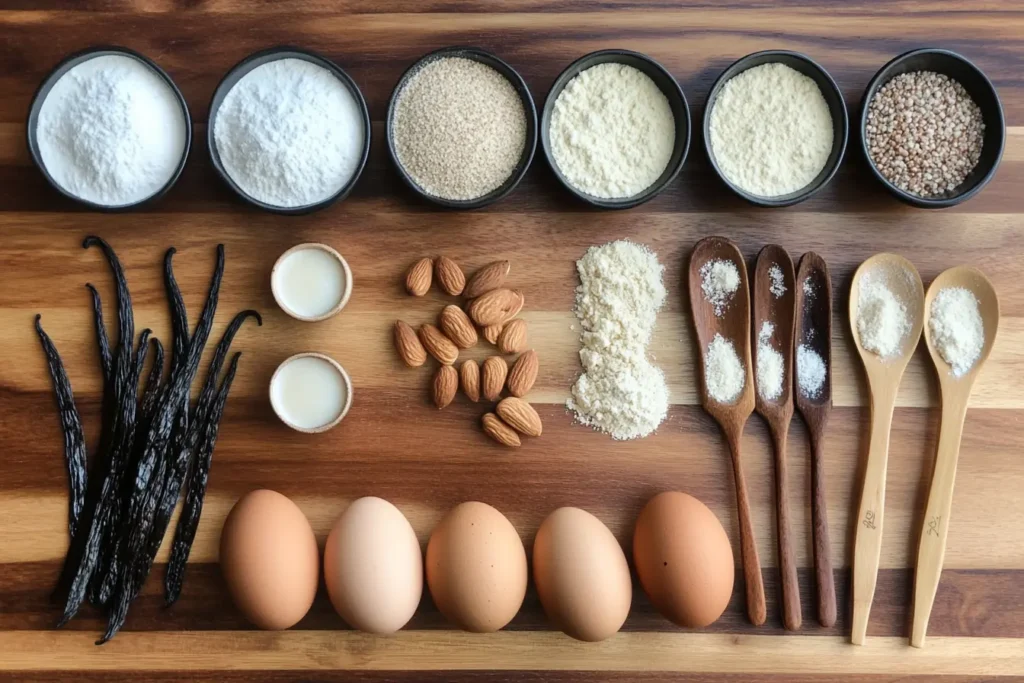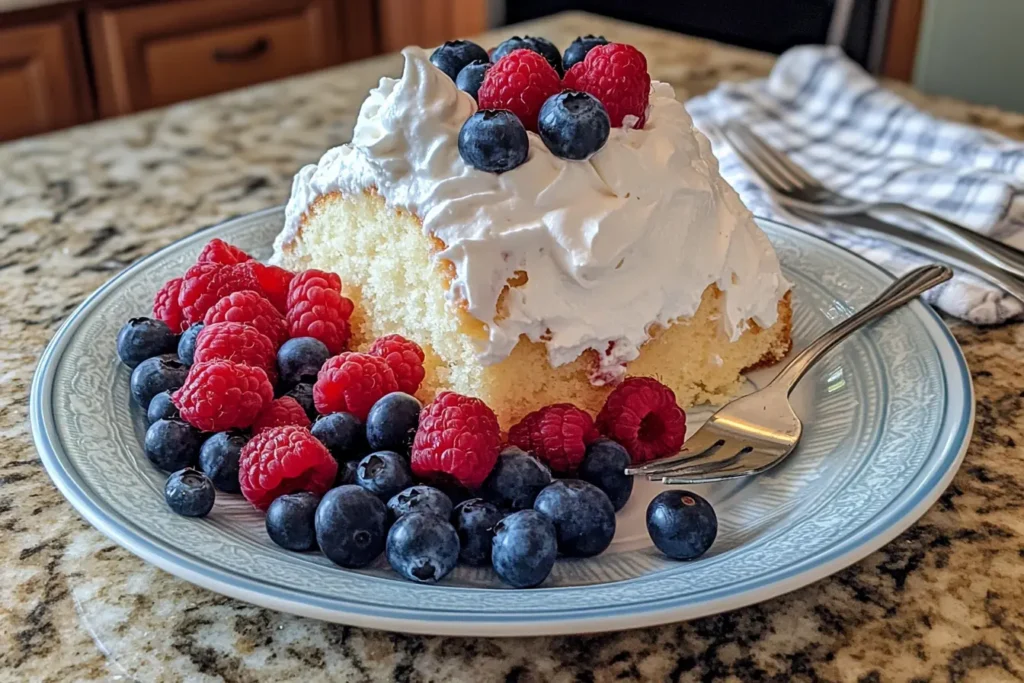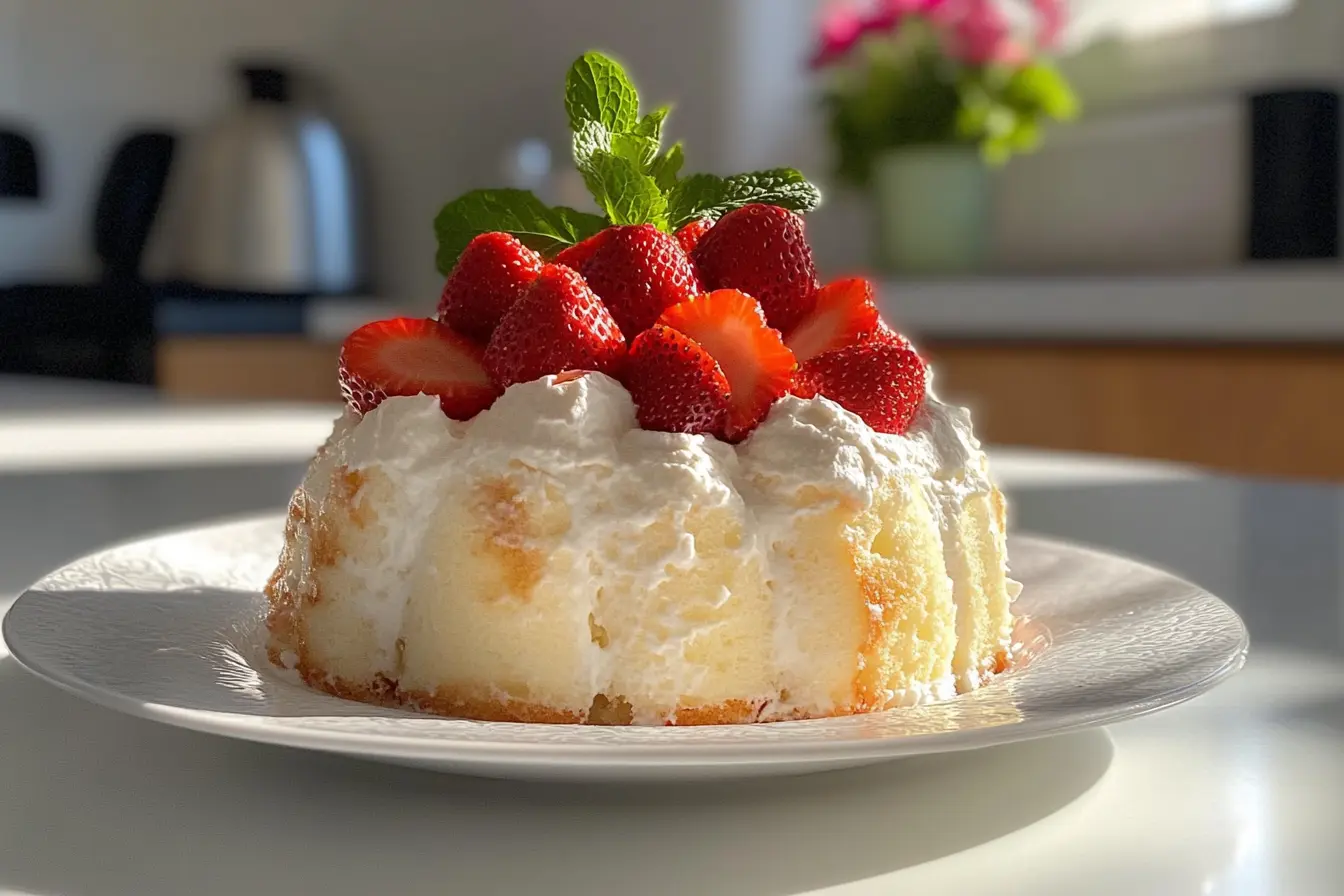Can Diabetics Have Angel Food Cake? Angel food cake, with its light and airy texture, often seems like a healthier dessert option. But is it suitable for diabetics? In this article, we’ll explore whether diabetics can enjoy this classic treat, discuss nutritional considerations, and share tips for modifying recipes to be more diabetes-friendly. Let’s get started and find out all you need to know!
Introduction
What is Diabetes and Why Diet Matters?
Diabetes is a chronic condition where the body struggles to regulate blood sugar levels due to insufficient insulin production or insulin resistance. As a result, people with diabetes must be mindful of their carbohydrate intake, which directly affects blood sugar levels. Desserts, often high in sugar and carbs, can be particularly challenging for diabetics to incorporate into their diets.
That said, it’s not all doom and gloom! With careful planning and modifications, desserts like angel food cake can fit into a diabetic-friendly meal plan. Understanding how specific foods impact blood sugar is crucial for making informed dietary choices.
What is Angel Food Cake?
Angel food cake is a unique, sponge-like dessert made primarily with egg whites, sugar, and flour. Its signature fluffy texture comes from whipped egg whites, and its low-fat content makes it stand out among traditional cakes. However, while it’s lower in fat and calories, it still contains sugar, which raises the question: Is angel food cake safe for diabetics?
This cake’s lighter composition and potential for adjustments make it a viable option when prepared mindfully. In this guide, we’ll explore ways to make angel food cake more compatible with a diabetic lifestyle while still keeping it delicious.
Nutritional Analysis
Ingredients in Angel Food Cake
Angel food cake is celebrated for its minimal ingredient list, which typically includes egg whites, sugar, cake flour, and cream of tartar. While these ingredients create a light and fluffy texture, some pose challenges for diabetics. The sugar content, in particular, can lead to spikes in blood glucose levels. Understanding what goes into this dessert is the first step toward making smarter dietary choices.
For instance, egg whites are a low-calorie, fat-free protein source, making them a diabetic-friendly component. However, the added sugar contributes significantly to the carbohydrate count, which is something diabetics must closely monitor.
Nutritional Breakdown
Here’s a look at the nutritional profile of a typical slice (100 grams) of traditional angel food cake:
| Nutrient | Amount per 100g |
|---|---|
| Calories | 258 kcal |
| Carbohydrates | 58 g |
| Sugar | 43 g |
| Protein | 5 g |
| Fat | 0 g |
| Fiber | 0.5 g |
| Sodium | 210 mg |
Comparative Analysis with Other Desserts
Compared to heavier cakes like pound cake or chocolate cake, angel food cake contains fewer calories and no added fats. For example:
- A slice of pound cake can have up to 400 calories and 18 grams of fat.
- A slice of chocolate cake can contain 350 calories, 15 grams of fat, and significantly more sugar.
Angel food cake stands out as a relatively lighter option, but moderation is still key. Its simple recipe also lends itself well to diabetic-friendly adaptations, which we’ll explore in the next sections.
Diabetic-Friendly Modifications
Recipes for Low-Sugar Angel Food Cake
Making angel food cake more suitable for diabetics involves reducing or replacing the sugar content. The good news? With the right substitutes, you can still enjoy a cake that’s light, fluffy, and delicious. Here’s what you can try:
- Sugar Alternatives: Replace granulated sugar with options like stevia, erythritol, or monk fruit sweetener. These provide sweetness without raising blood glucose levels.
- Low-Carb Flour Blends: Use almond flour or coconut flour instead of traditional cake flour. These options are lower in carbohydrates and higher in fiber, making them diabetic-friendly.
Ingredient Substitutes
In a traditional recipe, sugar provides structure and stability to the whipped egg whites. Replacing it with sugar alternatives can alter the texture slightly, but using a mix of erythritol and stevia helps retain the cake’s characteristic fluffiness. Here are some suggested swaps:
- For Sugar: Use 1:1 granulated erythritol or a stevia blend.
- For Cake Flour: Use a combination of almond flour and arrowroot powder.
- For Toppings: Opt for fresh low-GI fruits like berries or a dollop of sugar-free whipped cream.
Homemade vs. Store-Bought
While store-bought options are convenient, they often contain hidden sugars or preservatives. Baking your own angel food cake gives you complete control over the ingredients, ensuring it’s as diabetic-friendly as possible. Homemade versions also allow for experimentation with flavors and textures to suit personal preferences.
How Do Modifications Affect the Taste?
With these adjustments, the cake remains light and airy, though the sweetness might be slightly muted depending on the sugar substitute used. Adding natural vanilla or almond extracts can enhance flavor without adding sugar.
Health Considerations for Diabetics
Impact on Blood Sugar Levels
One of the biggest concerns for diabetics when eating desserts like angel food cake is how it will affect blood sugar levels. Traditional recipes, loaded with sugar, can cause rapid spikes in glucose. However, when prepared with sugar substitutes and low-carb flour alternatives, the glycemic impact is significantly reduced.
Angel food cake’s original recipe, despite being fat-free, has a high glycemic index due to the sugar content. By using substitutes like erythritol or stevia, you create a dessert with a lower glycemic load, which is much friendlier to a diabetic diet.
Portion Control
Even when modified, angel food cake should be consumed in moderation. For diabetics, portion control is essential to prevent overloading on carbohydrates, even those derived from healthier alternatives. A good rule of thumb is to enjoy a slice no larger than 1/12 of the cake, which typically equates to about 80 calories and minimal sugar if made with substitutes.
Tips for portion control:
- Pre-slice the cake into individual servings.
- Serve with fiber-rich foods like fresh berries to slow glucose absorption.
- Avoid adding high-sugar toppings like syrups or sweetened cream.
Combining with Other Foods
Pairing angel food cake with low-GI foods can further minimize blood sugar fluctuations. Here are some pairing ideas:
- Berries: Blueberries, raspberries, or strawberries are naturally low in sugar and add a refreshing twist.
- Greek Yogurt: Use unsweetened Greek yogurt as a creamy, protein-rich topping.
- Nuts: Sprinkle chopped almonds or walnuts for added crunch and healthy fats.
These combinations not only improve the nutritional profile of the dessert but also enhance its flavor and satisfaction factor.
Practical Tip: Keep a blood glucose monitor on hand to track how your body responds to modified recipes, ensuring they align with your dietary needs.
Recipes and Preparation Tips
Simple Sugar-Free Angel Food Cake Recipe
If you’re craving a fluffy, guilt-free dessert, this sugar-free angel food cake recipe is the perfect solution. By using diabetic-friendly ingredients, you can create a delicious treat that doesn’t compromise on taste.
Ingredients
- 1 cup of almond flour
- 1/4 cup of arrowroot powder
- 1 1/2 cups of erythritol (or a granulated sugar substitute of your choice)
- 12 large egg whites (room temperature)
- 1 tsp of cream of tartar
- 1/4 tsp of salt
- 1 tsp of vanilla extract
- 1/2 tsp of almond extract (optional)

Step-by-Step Instructions
- Preheat the Oven:
Preheat your oven to 350°F (175°C). The batter must adhere to the sides of the angel food cake pan in order to properly rise, therefore do not grease it. - Prepare the Dry Ingredients:
In a small bowl, sift together almond flour, arrowroot powder, and half the erythritol. Set aside. - Whip the Egg Whites:
In a large mixing bowl, use an electric mixer to beat the egg whites, cream of tartar, and salt on medium speed until soft peaks form. Gradually add the remaining erythritol while mixing, one tablespoon at a time, until the mixture becomes glossy and forms stiff peaks. - Incorporate the Dry Ingredients:
Gently fold the dry ingredients into the whipped egg whites using a rubber spatula. Add them in small batches to avoid deflating the batter. - Add Flavoring Extracts:
Stir in the vanilla and almond extracts for added aroma and depth of flavor. - Transfer to Pan:
Fill an angel food cake pan that has not been oiled with batter. Smooth the surface with a spatula. - Bake the Cake:
The top should be golden brown and bounce back when softly touched after 35 to 40 minutes of baking. - Cool and Serve:
Invert the pan immediately after removing it from the oven, allowing the cake to cool completely. Once cooled, run a knife along the edges to release the cake. Serve plain or with your choice of diabetic-friendly toppings.
Nutritional Content (per 100g)
| Nutrient | Amount per 100g |
|---|---|
| Calories | 120 kcal |
| Carbohydrates | 12 g |
| Sugar | 2 g |
| Protein | 8 g |
| Fat | 3 g |
| Fiber | 1.5 g |
| Sodium | 120 mg |
Variations and Flavor Enhancements
- Add unsweetened cocoa powder to make a chocolate version.
- Incorporate lemon zest for a zesty, refreshing twist.
- Top with sugar-free berry compote for extra flavor.
Tips for Using Natural Sweeteners
Using sweeteners like stevia or erythritol in baking requires some adjustment. Here are tips to ensure success:
- Use granulated sweeteners for texture similar to sugar.
- Blend sweeteners to avoid an overpowering aftertaste.
- Measure carefully to prevent over-sweetening or texture issues.

FAQs
Is Angel Food Cake Good for Diabetics?
Angel food cake can be a good option for diabetics when prepared with sugar substitutes and consumed in moderation. Its low-fat content makes it lighter than most cakes, but traditional recipes can still be high in sugar and carbs. By using natural sweeteners and low-carb flour, you can make this dessert much more diabetes-friendly.
What Distinguishes Angel Food Cake from Other Cakes?
Angel food cake is unique due to its absence of butter or oil, relying instead on whipped egg whites to achieve its airy texture. It’s also lower in calories and fat compared to heavier cakes like chocolate or pound cake. However, it traditionally contains a high sugar content, which can be modified for diabetics.
Can Diabetics Eat Desserts Regularly?
Yes, diabetics can enjoy desserts, but it’s all about balance and portion control. Opting for low-sugar or sugar-free recipes, like a modified angel food cake, and monitoring blood sugar levels ensures safe enjoyment. It’s also essential to pair desserts with other low-GI foods to minimize blood sugar spikes.
How to Make Store-Bought Angel Food Cake Healthier?
If you opt for a store-bought version, there are still ways to make it more diabetic-friendly:
- Reduce portion sizes.
- Top with low-GI fruits like blueberries or strawberries.
- Avoid sugary toppings like syrups or frostings.
- Check the label for added sugars and preservatives before purchasing.
What Are Some Alternatives to Angel Food Cake for Diabetics?
Diabetics can explore other low-sugar desserts, such as:
- Flourless almond cakes made with stevia.
- Chia seed puddings sweetened with monk fruit.
- Low-carb cheesecakes with almond crusts.
These alternatives provide variety while maintaining a focus on blood sugar management.
What Happens if a Diabetic Eats Too Much Sugar?
Overindulging in sugar can lead to rapid spikes in blood glucose levels, causing symptoms like fatigue, thirst, and even more serious complications if not managed promptly. Diabetics should always monitor their blood sugar and aim for balanced meals to avoid these issues.
Conclusion
Key Takeaways for Diabetics and Desserts
Angel food cake can be a viable dessert option for diabetics, especially when thoughtfully modified to reduce sugar and carbohydrate content. Its low-fat and airy texture make it a lighter choice compared to other cakes, and by using sugar substitutes like stevia or erythritol, you can transform it into a diabetic-friendly treat. However, moderation remains crucial.
Pairing angel food cake with low-GI toppings such as fresh berries or unsweetened Greek yogurt can further enhance its compatibility with a diabetic diet. These simple adjustments allow diabetics to indulge in sweets while keeping their blood sugar levels stable.
Positive Encouragement
Having diabetes doesn’t mean giving up on desserts entirely—it’s about making smarter choices and enjoying them mindfully. With recipes like a sugar-free angel food cake, you can savor moments of sweetness without guilt. Remember, managing diabetes is a journey, not a restriction. By experimenting with healthier alternatives, you’ll discover that enjoying your favorite foods is still possible.


1 thought on “Can Diabetics Enjoy Angel Food Cake? Tips and Recipes for Sweet Success”